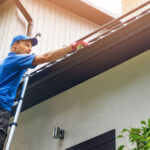It’s that time of year to prepare your home for the colder seasons. Here are some essential routines for getting ready for fall and winter.

1. Change Your Heater Filters
If you have a forced air centralized heating system, replace your air filters. Either they have been running all year long, in which case they are dirty, or they have been sitting stale for months, possibly growing mold and mildew. In either case, they are easy to replace. While you are at it, turn on the heater system at a moderate setting for several hours during the day while you are gone. That will give the system a chance to blow out all the dust it may have accumulated during the warm months. You can then air out the house when you get home. This is much better than having to deal with the smell of burnt dust when it is 40 degrees outside, and is a lot cheaper than paying for heating duct cleaning.
2. Check Your Vents and Fireplace Flues
With cold weather around the corner, you want to make sure to close any vents where heat can leak out. You will also want to verify that the flues are operating properly before you light the cozy winter fire.
3. Change and Test the Batteries in Your Smoke Alarms
Most fire departments run “fire alarm battery change” campaigns to coincide with the Daylight Savings time changes. Check both your battery-operated alarms and the ones wired into your home electrical system.
4. Tune Up Your Heating System
For about $80 to $100, a technician will inspect your furnace or heat pump to be sure the system is clean and in good repair, and that it can achieve its manufacturer-rated efficiency. The inspection also measures carbon-monoxide leakage.
5. Reverse Your Ceiling Fans
If your ceiling fan has a reverse switch, use it to run the fan’s blades in a clockwise direction after you turn on your heat. The fan will produce an updraft and push down into the room heated air from the ceiling (remember, hot air rises). This is especially helpful in rooms with high ceilings, and it might even allow you to turn down your thermostat by a degree or two for greater energy savings.
6. Caulk Around Windows and Doors
If the gaps between siding and window or door frames are bigger than the width of a nickel, you need to reapply exterior caulk (check the joints in window and door frames, too). Silicone caulk is best for exterior use because it won’t shrink, and it’s impervious to the elements. Try GE’s Silicone II Window and Door product ($6 at Home Depot). Check window-glazing putty, too (which seals glass into the window frame).
7. Turn Off Exterior Faucets
Undrained water in pipes can freeze, which will cause pipes to burst as the ice expands. Start by disconnecting all garden hoses and draining the water that remains in faucets. If you don’t have frost-proof faucets (homes more than 10 to 15 years old typically do not), turn off the shut-off valve inside your home.
8. Mulch Leaves When You Mow
Mow your leaves instead of raking them. The trick is to cut the leaves, while dry, into dime-sized pieces that will fall among the grass blades, where they will decompose and nourish your lawn over the winter.
9. Don’t Prune Trees or Shrubs Until Late-Winter
You may be tempted to get out the pruning shears after the leaves fall, when you can first see the underlying structure of the plant. However, horticulturalists advise waiting to prune until late winter for most plants, when they’ve been long dormant and just before spring growth begins.
10. Get on Top of Roof Problems
Few homeowner problems are more vexing than a leaky roof. Once the dripping starts, finding the source of the problem can be time-consuming. Stop problems this fall before ice and winter winds turn them from annoyances into disasters.
Happy Fall!
Click here to Contact Us to ask questions or suggest topics. We really listen.



